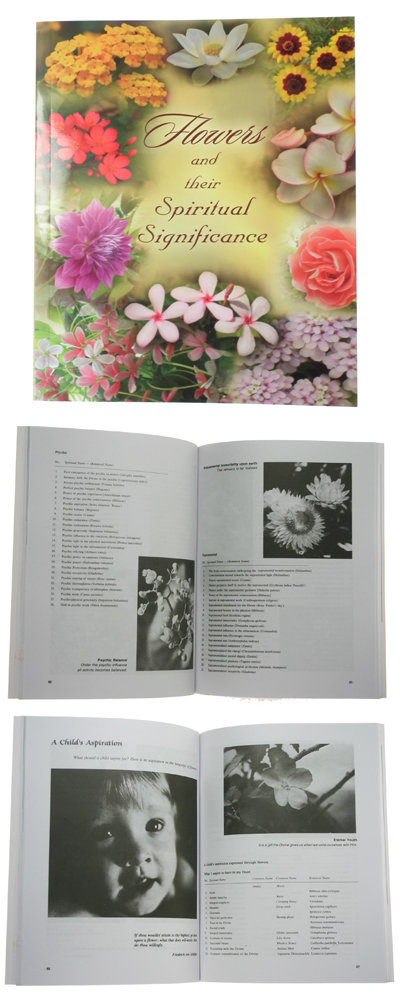Flowers – their Spiritual Significance
Dit engelstalige boek (96 pagina’s) bevat meer dan 800 bloemen met hun spirituele betekenis. Door in contact te gaan met de natuur van een bloem, zijn innerlijke waarheid…weet men wat de bloem vertegenwoordigt…als je ermee in contact bent, als je
Dit engelstalige boek bevat meer dan 800 bloemen met hun spirituele betekenis. Het boek bestaat uit 96 pagina’s, met diverse zwart-wit foto’s van de bloemen genoemd in het boek.
Onderstaand vind je enkele stukjes genomen uit het boek:
Introduction
What are flowers? Are they not messengers of love, prayers of the vegetal world, the aspiration and adoration of Nature, the smile of the Divine? Says Sri Aurobindo in his epic poem, Savitri: “The world’s senseless beauty mirrors God’s delight. That rapture’s smile is secret everywhere; It flows in the wind’s breath, in the tree’s sap, Its hued magnificence blooms in leaves and flowers .”
Flowers may appear frail and fleeting, but for a brief moment they bring a touch of eternity, of joy and beauty which lie beyond the sorrows and cares of the human world. In the beautiful words of Sri Aurobindo,
” Earth’s flowers spring up and laugh at time and death.” In all countries flowers have been associated with religion and worship, with myths and legends. And to people all over the world they have been symbols of love and remembrance. A flower contains all the elements of Nature – air, water, fire, earth and ether. Apart from its beauty of form, colour, fragrance and texture there is something more – an indefinable, subtle and mysterious quality about it. In the words of Liselle Raymond, “in its simplicity, it carries the vibrations of the Akasha the ethereal element itself, – that is all that is most abstract, pure and perfect. It is, above everything else, the form, behind which is the sound, the all powerful creative Mantra. ”
This is why flowers have charmed and attracted men and women alike, down the ages. It is this subtle element, their soul which has given them a very special place in the life of men and of communities. This is very evident in the Sri Aurobindo Ashram at Pondicherry, where the Mother has revealed the spiritual meaning of flowers, where the flowers are tended with great love, affection and care and are looked upon as powerful means of finding oneself and communing with the Divine.
This book primarily focuses its attention on this new, and not so commonly known, spiritual and deeper aspect of flowers. The flowers have been grouped together according to certain themes in various chapters. The book also takes in its ambit articles from different lands which reveal the many facets of one of the most wonderful of Nature’s creations. We begin to see the great truth contained in the lines of Tennyson,
“Little flower – but if I could understand What you are, root and all, and all in all, I should know what God and man is.”
Yes, if only we could understand or, rather, if only we could be like a flower. Indeed this, in a way, is the entire theme of the book. If it can help to kindle this aspiration in even a few of us, the book will have served its purpose.
Of all the messages sent through flowers, the one which is predominent, is love. May we pray with the Mother,
“0 Lord, let this pure flower of love blossom in me, so that it may make fragrant all who approach me and its perfume sanctify them.”
Flowers – their Spiritual Names
Flowers are the ‘wordless prayers of Nature’, beautiful expressions of its yearning for the Divine. And each flower has its unique aspiration, its own vibration, its true meaning.
Very rarely do the botanical or the common names given to flowers represent their true meaning. The Mother has given spiritual names to nearly eight hundred flowers revealing their deepest aspiration. She has also described the process, though it is not something which can be done by the mind. In several cases, the name given by the Mother is very much in harmony with the common name given traditionally or the use to which a flower is put, specially in worship.
The lotus, the flower of the gods, is named by the Mother the Avatar or the. Divine Consciousness. Tulsi is an inseparable part of all worship in India and is offered to Vishnu and Krishna. The name given by the Mother to Tulsi is ‘Devotion’. Shiva, the eternal ascetic, is offered the wild Dhatura flower which the Mother called ‘Tapasya’ meaning askesis. Kali, the mighty Goddess of strength, is worshipped with the red hibiscus, named ‘Power’ by the Mother. And then we have the Mudar, named ‘Courage’ by the Mother, which is offered to Hanuman, the courageous and devoted servitor of the Divine. The Sunflower, forever facing the sun, is ‘Consciousness turned towards the Divine’. And what about those unforgettable tiny flowers popularly known as ‘Forget-Me-Not’? To these, the Mother has given the name of ‘Lasting Remembrance’. The bright orange flower of the tree called ‘Ashoka’ in lndia, under whose spreading branches captive Sita sat in Lanka, means in Sanskrit exactly what the Mother has called it, ‘Without Grief.
There are other flowers whose significance, as given by The Mother, has reference to the name of a god or goddess, in particular there are several flowers named after Krishna. Most of these flowers are blue, the colour associated with Krishna and, in the Water Hyacinth called by the Mother ‘Krishna’s play in the Vital’, one can even see the peacock plume.
Mother, when flowers are brought to you, how do you give them a signiflcance?
To the flowers? But it’s in the same way, by entering into contact with the nature of the flower, its inner truth. Then one knows what it represents.

